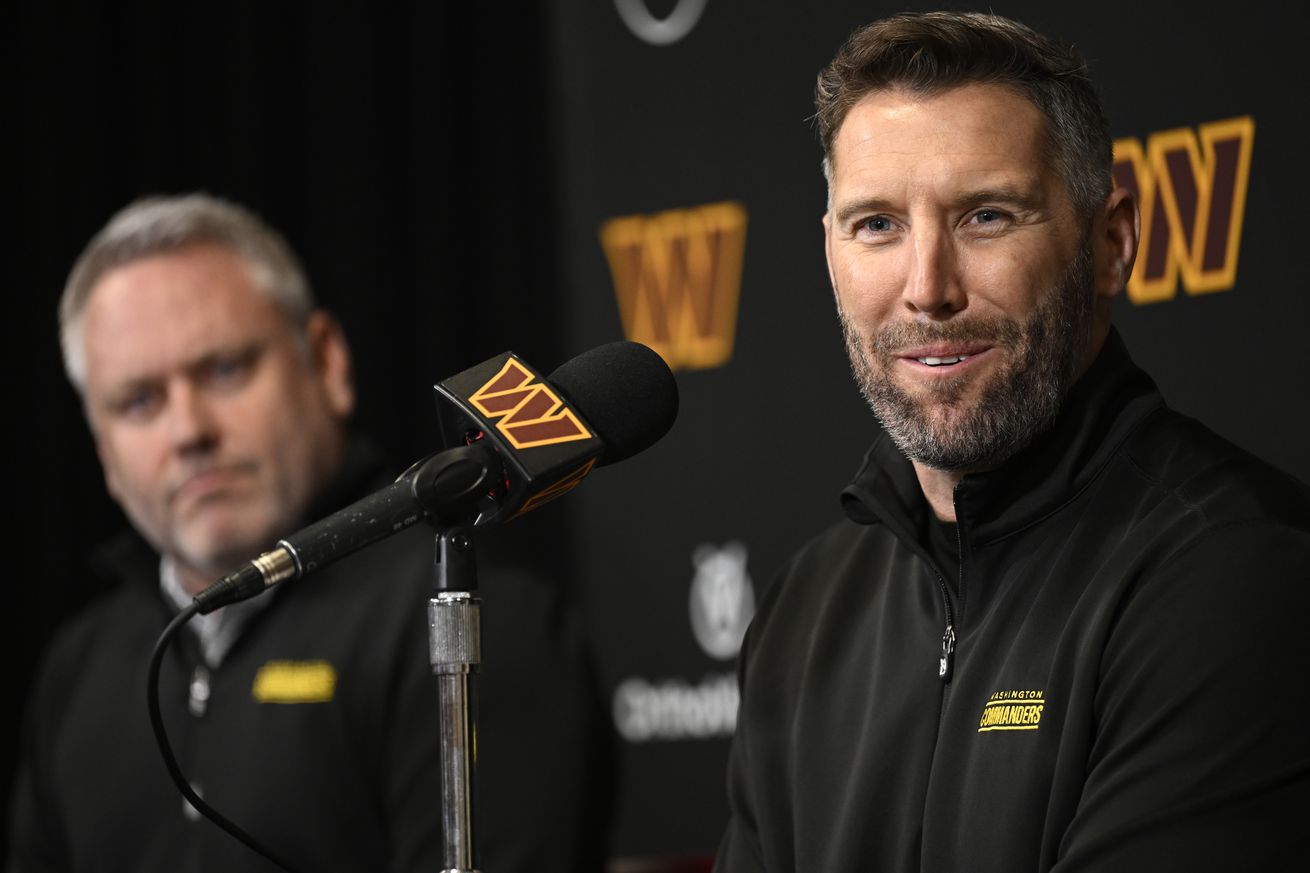
More insights into how the Commanders’ new front office thinks about the draft
Last year, new Commanders’ GM Adam Peters abrought in sweeping changes to the way that the team approaches the NFL draft. I previewed Peters’ approach before the draft and then followed up in a series of articles after player selections concluded (What we learned 1, 2, 3).
In sharp contrast to the previous regime, Adam Peters’ approach is collaborative, drawing on input from everyone in the building, including a new R&D department which generates custom-made metrics to identify players who fit the team’s schemes and uses cutting edge neurobehavioral methods to optimize player performance.
The collaborative process starts when the scouting department identifies players of interest during the college football season and continues right through the draft, including a whole-franchise meeting before Day 3 providing a venue for area scouts to highlight favorite prospects to management, and the head coach being consulted on draft picks as they occur.
Peters’ draft process emphasizes character and culture fit in player evaluations, in addition to measurables and on-field performance. We also learned that he has a preference for prospects with elite athletic profiles.
Fans were surprised by some of the choices. After the fact, we learned that the Commanders had stuck religiously to their board, prioritizing best available talent over immediate roster needs throughout Days 1 and 2 when likely early contributors come off the board.
This year’s draft season reinforced many of those lessons and provided a few new insights into how Peters’ front office thinks about team building. Here are some key takeaways from Adam Peters’ choices with Commanders’ draft picks before and during the 2025 draft.
This one got a little long, so I will give it to you in two parts.
Adam sticks to his board and player valuations
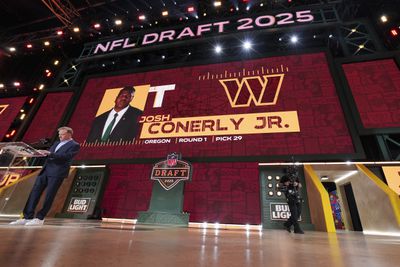
Photo by Perry Knotts/Getty Images
In his first draft with the Commanders, Peters surprised the media and fans alike, by selecting defensive tackle Johnny Newton early in the second round, despite already having two defensive tackles on premium starting contracts.
This year, he disappointed fans who were expecting him to trade back from 29 to get more picks, and left fans and media analysts alike wondering why he didn’t draft an edge-rusher, despite a glaring need for an upgrade at the position.
While these decisions may seem counterintuitive to fans, they have a common explanation which is deeply rooted in Peters’ draft philosophy.
The Commanders’ trades for veterans Marshon Lattimore, Deebo Samuel and Laremy Tunsil left them with just five selections in the draft and only two in the top 100. In his pre-draft press conference with Assistant GM Lance Newmark, Peters indicated that the team was open to trading back to add more picks. However, when the opportunity arose, the Commanders turned down trade offers and stuck at 29 to draft Oregon OT Josh Conerly Jr. Peters explained their thinking:
“We got a ton of calls when we were on the clock. We got calls throughout the week, just preliminary calls…And then we got a ton of calls leading up to that.”
“And what we had discussed beforehand is really, if he was on the board, we weren’t gonna trade back,” Peters said. “There was an opportunity to trade back with a few other teams and wasn’t very far, but in our minds it was not worth even risking missing on him.”
Peters’ collaborative approach involves all departments in the organization in constructing the team’s board, from area scouts, to the R&D (analytics) team, coaching staff and management. The selection process goes beyond measurables and on-field performance to consider character make-up and culture fit. This year, Conerly aced their process, and emerged as the top choice at pick 29, with unanimous support from all corners of the organization:
“He was the highest player on our board, is really what it ended up being,” Peters said. “It wasn’t really so much we needed to get an O-Lineman or anything like that, but he was clearly the highest player on our board.”
Adam drafts the player, not the position
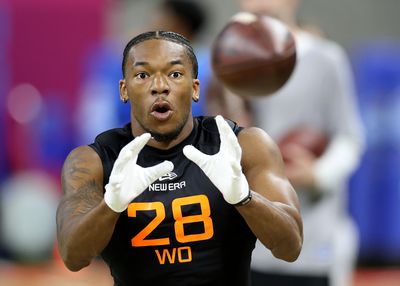
Photo by Stacy Revere/Getty Images
While the selection of Conerly addresses the long-term need to upgrade the protection for QB Jayden Daniels, and potentially improves the blocking for Kliff Kingsbury’s rushing attack, many fans and media analysts felt that Edge rusher was a more pressing need, deserving more urgent attention with the team’s first round pick.
In fact, the Commanders went through the entire draft without picking an edge rusher. Why would they overlook such an important roster gap in the draft? The answer is the same as the reason they picked Conerly in the first round, as explained in the post-draft presser:
“It wasn’t, ‘We weren’t going to address edge at any point,’” assistant general manager Lance Newmark said at the end of the seventh round. “There were never any conversations of that mindset. It was, ‘These players made the most sense for us.’”
Under Adam Peters’ leadership, the Commanders’ front office sticks to their board and picks the best available players. The available Edge rushers just didn’t align with their board at any of their picks.
In the second round, the Commanders selected Ole Miss CB Trey Amos. This was a popular choice in the draft room and was a particular favorite of the analytics team, for good reason. Speaking after Day 2, Peters revealed that the Commanders had him rated so highly they would have considered taking him at 29, if Conerly had not been available.
That left it to the fourth round for the Commanders to find a player to upgrade the edge rush this season, which is a low probability proposition in any draft. Unfortunately for fans feeling an acute need at the position, there was a small run on edge rushers right before the Commanders’ pick:
David Walker, Central Arkansas to Buccaneers at 121
Jack Sawyer, Ohio State to Steelers at 123
Barryn Sorrell, Texas to Packers at 124
Kyle Kennard, South Carolina to Chargers at 125
That left a few edge options remaining on the board who had been discussed on Hogs Haven, or had received attention from the Commanders before the draft. These included Bradyn Swinson (LSU, Patriots 146), Elijah Roberts (SMU, Bucs 157) and Tyler Baron (Miami, Jets 176). These prospects all had to wait half a round or more to get the calls from their new teams in the fifth round. While some of these players might have upside to eventually crack a starting roster, none profiles as a likely Day 1 contributor to upgrade the position this season.
Instead of reaching for a developmental project at edge with the fourth-round pick, Peters stuck to his board and picked a player who is likely to contribute from Day 1 and upgrade the return game, with upside to develop as an offensive weapon as well. From Peters’ call to Jaylin Lane informing him he was the newest Commander:
“Turn around and tell them you’re going to be a true Commander, man,” Peters told Lane via the Commanders’ X account. “You’re a ‘BMF’ [and] you’re exactly what we’re looking for. You’re a Commander on our board [and] the top punt returner on our board. We were thrilled that you were here, man. Congratulations.”
Jaylin Lane got the Commander tag and was the top punt returner on Washington’s boardpic.twitter.com/7yiBuULfn5
— COMMANDERS FOOTBALL (@HogsHaven) April 26, 2025
It’s a marathon, not a sprint
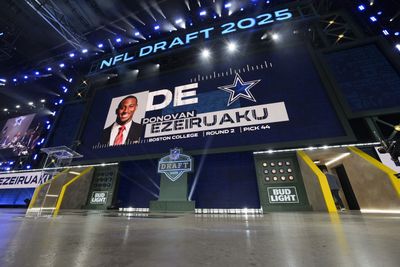
Photo by Perry Knotts/Getty Images
Following the Commanders’ opening day loss to the Buccaneers, I published an article on the timelines of recent successful rebuilds from comparable starts. The 49ers, Bills, Lions and Texans all took a minimum of three seasons to achieve their first playoff wins under new regimes. The Bills and Lions actually took longer, because I didn’t include their initial false starts under unsuccessful GMs in the timelines.
The Commanders instant return to post-season relevance was the biggest surprise of the 2024 season. It was, in fact, the most dramatic turnaround in the salary cap era, at least. To many in the fanbase and media, the sudden reversal of the team’s fortunes places new urgency on Adam Peters’ roster “recalibration”, prompting calls for him to push all his chips to the middle of the table to capitalize on the unexpected playoff window, while it lasts.
Fans expecting Peters’ first pick to be an instant contributor on defense were surprised when OT Josh Conerly Jr was announced as the pick at 29. The offensive line performed better than many expected in 2024, and was bolstered by the trade for Laremy Tunsil. While there is still plenty of room to improve the Commanders’ blocking up front, the biggest weakness last season was on defense. Hogs Haven polling before the draft revealed a widespread belief that the team had not adequately compensated for the departure of its top pass rusher, Dante Fowler, in free agency.
More obscure voices have also argued that the team’s biggest overall weakness – run defense – was barely addressed in offseason moves prior to the draft.
There were several prospects on the board who fit the bill as instant upgrades on defense when the Commanders were on the clock. Prominent names included LB hybrid Jihaad Campbell, Edges Donovan Ezeiruaku, Mike Green, Nic Scourton and JT Tuimoloau, and safety Nick Emmanwori, as well as CBs Maxwell Hairston and Trey Amos. The Commanders had shown considerable interest throughout the draft process in Ezeiruaku, Hairston and Amos.
The Commanders’ choice, Josh Conerly Jr, brings the elite athletic traits and strong fundamentals to a premium position on offense. But he is young and may take some time to add play strength before he is ready to take on NFL bull rushers and generate movement at the point of attack.
Of course, nothing is written in stone at this point. Conerly’s standout performances against top college opponents, including Abdul Carter, provide some hope that he may be ready to start earlier rather than later. But it would not be a surprise if it takes him the better part of the season, or longer, to win the competition for playing time with established starter, Andrew Wylie. We could also see him platoon with Wylie, or another player at RT, to ease his transition to the NFL before becoming a full-time starter. The main point is that he profiles as a high-upside prospect who may need some time to adjust to the NFL, rather than a Day 1 impact addition. Players who fit the latter profile were available.
This pick, like last year’s selection of Johnny Newton 36th overall, was about maximizing return for investment by picking the best player available, rather than reaching down the board to address a more pressing need. Fans expecting the team to prioritize immediate contribution over long-term impact are likely to have more surprises and disappointments future drafts.
Maybe some sprinting’s needed to win the marathon
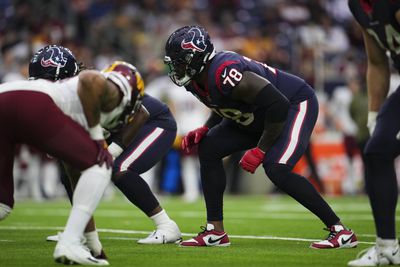
Photo by Cooper Neill/Getty Images
While Peters’ player selections in his first two drafts in Washington have reflected a disciplined commitment to Best Player Available principles, not all of his use of draft capital has. In fact, his fourth-biggest move, in terms of draft capital expenditure, was this off-season’s trade for LT Laremy Tunsil. This provided an instant upgrade to Jayden Daniels’ protection, with a net loss of three picks in this and next year’s draft.
To acquire Tunsil and a fourth-round pick this year, the team shipped picks 79 and 236 in this year’s draft to Houston, along with second- and fourth-round picks next year. The net expenditure for this trade will be around 143 to 160 pts according to the Rich Hill trade value chart if the Commanders finish in the playoffs next year, and more if they don’t. That’s equivalent to giving away an early second-round pick.
The trade was generally considered to be good value for the Commanders, because the team acquires a quality starter at a high-replacement-cost position, with lower risk and less lead time than upgrading the left tackle position in the draft. In that sense, it was probably necessary, because fixing all of the roster holes left by the previous regime through the draft is unrealistic.
But the trade did incur a fairly steep cost in terms of cashing in future investment capital for short-term gain. Instead of having three chances in the 2025 and 2026 drafts to add players on rookie contracts for four years, the Commanders acquired a single player under contract for two years. Of course, Tunsil is a known quantity, and the draft prospects Washington will have to forgo are anything but sure bets. Based on historical data, the chance that three players selected in rounds 2-4 will all become starters is well south of 50%. But the point remains that trading draft picks for veterans shortens the horizon for return on investment from the team’s draft capital.
The same logic applies equally to last year’s midseason trade for Marshon Lattimore, in which the Commanders sent picks 93, 131 and 184 to New Orleans, in exchange for Lattimore and pick 147, and to trading 147 to the 49ers for Deebo Samuel. Although the impact of the Deebo trade is fairly minimal.
These trades reveal that, while Peters may be committed to a future focus within the draft, he is not averse to mortgaging some of the team’s future to get better right away, when the right opportunity presents itself.
It can be argued that these moves were necessitated by the state Ron Rivera left the roster in at key positions, given the uncertainty and timeline of building through the draft. But the fact remains that the Commanders were left with 10 picks in the 2025 and 2026 drafts. If the Commanders are truly committed to the build through the draft philosophy that Peters espouses, they will need to make a transition from a net expender of draft picks to a net accumulator. Perhaps this off-season’s additions will get the roster over the hump to make that possible.